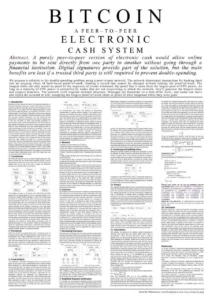The Genesis – 2008 and Satoshi’s Vision
Let’s rewind to 2008—a year that hit like a sledgehammer for millions. Picture this: banks collapsing like dominoes, families losing homes, jobs vanishing overnight. The news was a parade of bailouts—big shots in suits getting rescued with taxpayer cash while regular folks got eviction notices. The subprime mortgage mess had blown up, exposing a financial system built on shaky bets and greed. Trust in banks? Gone. Faith in governments to fix it? Out the window. People watched their savings evaporate as Wall Street got a golden parachute, and the question burned: who’s looking out for us? This wasn’t just a crisis—it was a wake-up call, and this lesson starts right there, in the rubble of that betrayal, where Bitcoin’s story begins.
Then came a ghost in the machine: Satoshi Nakamoto. No one knows who they were—a lone genius, a group, maybe even your quirky uncle who’s good with computers—but in October 2008, they dropped a bombshell. It was a nine-page paper titled “Bitcoin: A Peer-to-Peer Electronic Cash System,” posted to an obscure cryptography email list. Sounds nerdy, right? But here’s the juice: Satoshi wasn’t just tinkering with code. They were proposing a way to cut out the middlemen—banks, governments, the whole rotten crew—and let people send money directly to each other, no permission needed. After 2008, when those middlemen had tanked the world, this wasn’t just clever—it was revolutionary. Imagine a world where your cash doesn’t need a banker’s blessing to move. That’s the spark Satoshi lit.

Fast forward to January 3, 2009—Bitcoin’s birthday. The first block, called the “genesis block,” went live, and Satoshi baked in a little Easter egg that says it all. Embedded in the code was a headline from that day’s Times newspaper: “Chancellor on brink of second bailout for banks.” It wasn’t just a timestamp—it was a battle cry. While the old system doubled down on failure, Bitcoin was born to defy it. No printing presses, no bailouts, just a network where value flows without a leash. For everyday people—like the factory worker who lost his pension or the mom scraping by—this was a whisper of something better: money that couldn’t be gamed by the powerful.
Why does this origin story hit home? Because 2008 wasn’t ancient history—it’s the scar tissue of our financial lives. Even now, we feel it: rents and housing spiking, groceries costing more, the sense that the system’s still rigged. Satoshi saw that coming and built Bitcoin to fight back. It’s not controlled by a CEO or a president—it’s a digital pact between users worldwide, secured by math, not promises. That crisis birthed a vision: a currency that’s scarce, not endless, and free, not chained. It’s not just tech—it’s a chance to reclaim power from a machine that’s been chewing us up for too long.
Bitcoin’s genesis is more than a history lesson—it’s the opening shot of a rebellion we’re all invited to join. Satoshi vanished after 2010, leaving no face, no fortune, just this gift. The whitepaper promised a fix for a world burned by trust, and the genesis block shouted, “We won’t forget.” This is where Bitcoin starts: not in a boardroom, but in the ashes of a system that failed us, offering a future where your money answers to you, not them. It’s the foundation for everything this course builds—how Bitcoin solves today’s woes and hands us hope we can hold onto.
